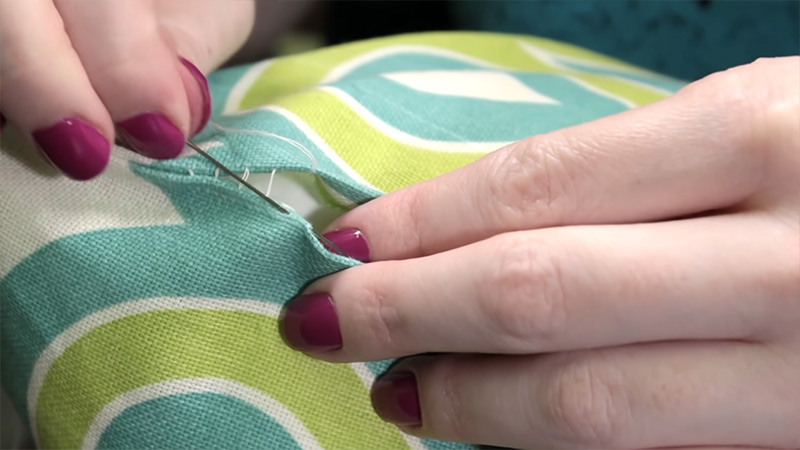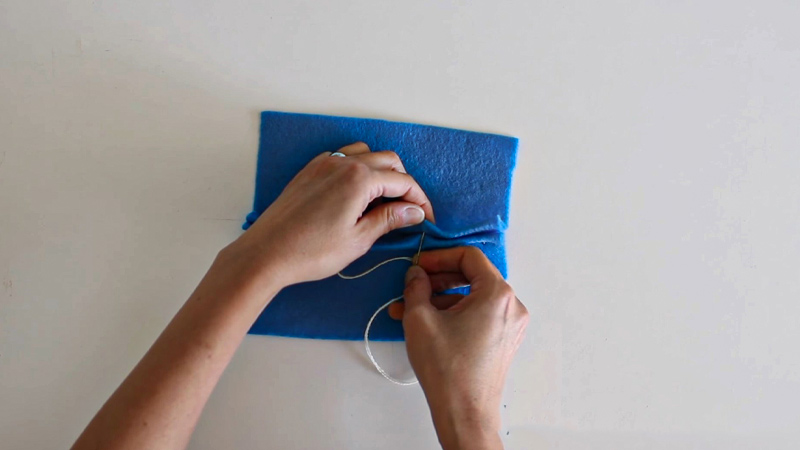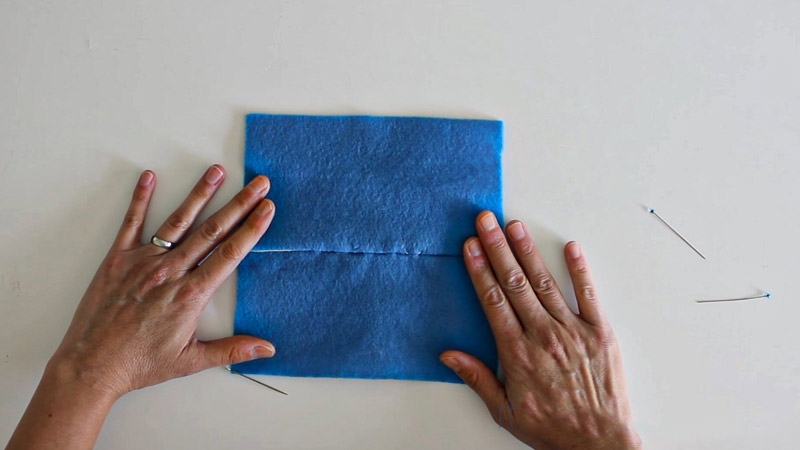Ladder stitch, a well-kept secret in the realm of sewing, is a subtle yet indispensable technique that transforms ordinary seams into seamless works of craftsmanship.
It’s the magician’s wand of hand-sewing, skillfully concealing stitches to create an impeccable finish.
This technique, also known as invisible or blind stitch, is the art of joining fabric edges discreetly, leaving no visible trace on the surface.
Like a hidden bond, a ladder stitch is used to close openings in garments, pillows, or fabric items with finesse.
Its mastery opens the door to a world of professional-grade sewing, where meticulous attention to detail results in a polished, flawless outcome.

The Definition of Ladder Stitch in Sewing
Ladder stitch, also known as invisible stitch or blind stitch, is a fundamental hand-sewing technique used in sewing and upholstery to create nearly invisible seams.
It is particularly handy for closing openings in fabric, like turning right-side-out after stuffing a pillow or closing a seam on a garment lining.
The key to ladder stitch’s near-invisibility lies in the way the needle is threaded through the fabric layers.
To execute a ladder stitch, you typically begin by folding the raw edges of the fabric inwards and aligning them.
Then, using a threaded needle (preferably matching the fabric color), you take small, evenly spaced stitches along the folded edges, alternating between each side.
As you progress, the stitches create a ladder-like pattern, hence the name. When you gently pull the thread tight and secure the ends, the seam closes neatly, leaving no visible stitches on the surface.
Ladder stitch is an invaluable skill for achieving professional-looking, seamless finishes in various sewing projects, from pillows and stuffed animals to clothing and home decor items.
Its inconspicuous nature makes it a favorite among crafters and seamstresses seeking a polished final product.
How to Sew a Ladder Stitch?

Sewing a ladder stitch, also known as an invisible or blind stitch, is a technique used to create nearly invisible seams, often used for closing openings in the fabric.
Here’s a step-by-step guide on how to sew a ladder stitch:
Materials You’ll Need:
- Fabric pieces you want to join.
- Matching thread.
- Hand-sewing needle.
- Straight pins.
Step 1: Thread the Needle
Start by threading your needle with a piece of thread that matches the color of your fabric. You can use a single strand of thread, and it’s a good practice to cut a reasonable length, usually no longer than your forearm, to avoid tangling.
Step 2: Prepare the Fabric
Fold the raw edges of the fabric pieces you intend to join inwards, aligning them as accurately as possible.
You can use straight pins to hold the fabric in place temporarily if needed. The alignment of the folded edges is crucial for a seamless result.
Step 3: Start the Stitch
Begin the ladder stitch by inserting your threaded needle from the inside of one fabric edge to the outside. Place your initial stitch about 1/8 inch (3-4 mm) away from the folded edge. Leave a small tail of thread inside, as this will be secured later.
Step 4: Create the Ladder Effect
Now, insert your needle from the outside of the other fabric edge, directly across from where your thread emerged in step 3. The needle should go through both folded fabric edges, creating a small, evenly-spaced stitch. This stitch should be as discreet as possible to maintain the invisible seam.
Step 5: Repeat the Process
Continue this process, alternating between the two fabric edges. Make sure your stitches are evenly spaced and consistently sized to create a ladder-like pattern.
Aim for stitches that are about 1/8 to 1/4 inch (3-6 mm) apart, depending on your preference and the fabric’s thickness.
Step 6: Tighten the Stitches
After every few stitches, gently pull the thread to tighten the stitches and close the seam. This step is crucial for achieving an almost invisible finish. Be cautious not to pull too tightly, as this can cause puckering or distortion in the fabric.
Step 7: Secure the End
When you’ve stitched the entire seam, it’s time to secure the end of your ladder stitch. To do this, insert the needle under the last stitch, creating a loop.
Pass the needle through the loop twice to form a small knot. Pull the thread tight to secure the knot.
Step 8: Trim Excess Thread
Trim any excess thread close to the knot, ensuring it’s hidden within the seam. Be careful not to cut too close to the knot, as this could cause it to come undone.
What Is a Ladder Stitch Used For?

A ladder stitch, also known as an invisible stitch or blind stitch, serves various purposes in sewing and crafting due to its ability to create nearly invisible seams.
Here are some common uses for a ladder stitch:
Closing Openings
When making pillows, stuffed animals, or garments that require turning right-side-out, the ladder stitches neatly seals the opening left for this purpose. It ensures a secure closure without any visible stitches, maintaining the project’s aesthetics.
Hemming
Ladder stitch is excellent for hemming lightweight and delicate fabrics like chiffon, silk, and organza. It provides an inconspicuous hemline that preserves the fabric’s elegance and drape.
Mending Tears
Whether it’s a ripped garment or a torn fabric item, the ladder stitch can mend the damage. It aligns and stitches the torn edges together, concealing the repair work effectively.
Attaching Linings
In sewing projects involving linings, such as jackets, skirts, or bags, the ladder stitch attaches the lining to the outer fabric. This keeps the lining securely in place while maintaining a seamless appearance on the outside.
Creating Invisible Seams
In quilting and patchwork, the ladder stitch is invaluable for joining fabric pieces with nearly invisible seams. This technique lends a cohesive and professional look to the overall design.
Appliqué
When attaching appliqué pieces, like decorative patches or motifs, the ladder stitch secures them to the background fabric while keeping the stitching lines hidden. This results in a polished and cohesive look.
Doll and Soft Toy Making
In the realm of crafting dolls and stuffed animals, the ladder stitch plays a central role. It’s used to close seams, attach limbs, and even add facial features with minimal visible stitching.
Cushion Covers
For creating cushion covers, especially those with intricate patterns or delicate fabrics, the ladder stitch is employed to close the cover after inserting the cushion or pillow form. This ensures a seamless and professional finish.
Repairing Upholstery
When it comes to upholstery work, the ladder stitch can mend seams or attach fabric pieces in a way that blends seamlessly with the rest of the upholstery. It maintains the overall aesthetic appeal of the furniture.
Creating Hidden Pockets
In sewing projects that involve hidden pockets, such as inside garments or bags, the ladder stitch is used to close the opening discreetly. This ensures that the pocket remains hidden while serving its functional purpose.
FAQS
Can I use a sewing machine to create a ladder stitch?
No, the ladder stitch is a hand-sewing technique. Its precise and nearly invisible nature relies on the control and precision of hand stitching.
Are there any alternatives to ladder stitches for closing openings in fabric?
Yes, you can use a slip stitch or whipstitch to close openings as well. However, the ladder stitch is preferred for its exceptional seam concealment.
Can I use ladder stitches on heavy or thick fabrics?
While ladder stitch is ideal for lightweight fabrics, it can also be used on heavier materials.
However, you may need to adapt your technique to accommodate the fabric’s thickness.
Is ladder stitch the same as ladder hemstitching?
No, ladder stitch and ladder hemstitching are different techniques.
Do I need to tie a knot at the beginning and end of a ladder stitch seam?
It’s advisable to tie a knot at the end of your ladder stitch to secure the seam.
To Recap
In sewing, the ladder stitch stands as a quiet hero, transforming ordinary seams into virtually invisible works of art.
Its versatility extends from closing openings with a seam that vanishes to seamlessly attaching linings, hemming delicate fabrics, and mending tears with finesse.
Mastering the ladder stitch is not merely a skill; it’s a gateway to achieving professional-level craftsmanship.
Its elegance lies in the ability to hide its own presence while securing fabric pieces together.
So, as you embark on your sewing journey, remember the ladder stitch it’s the secret behind impeccable, polished finishes that elevate your creations from mundane to magnificent.
Leave a Reply